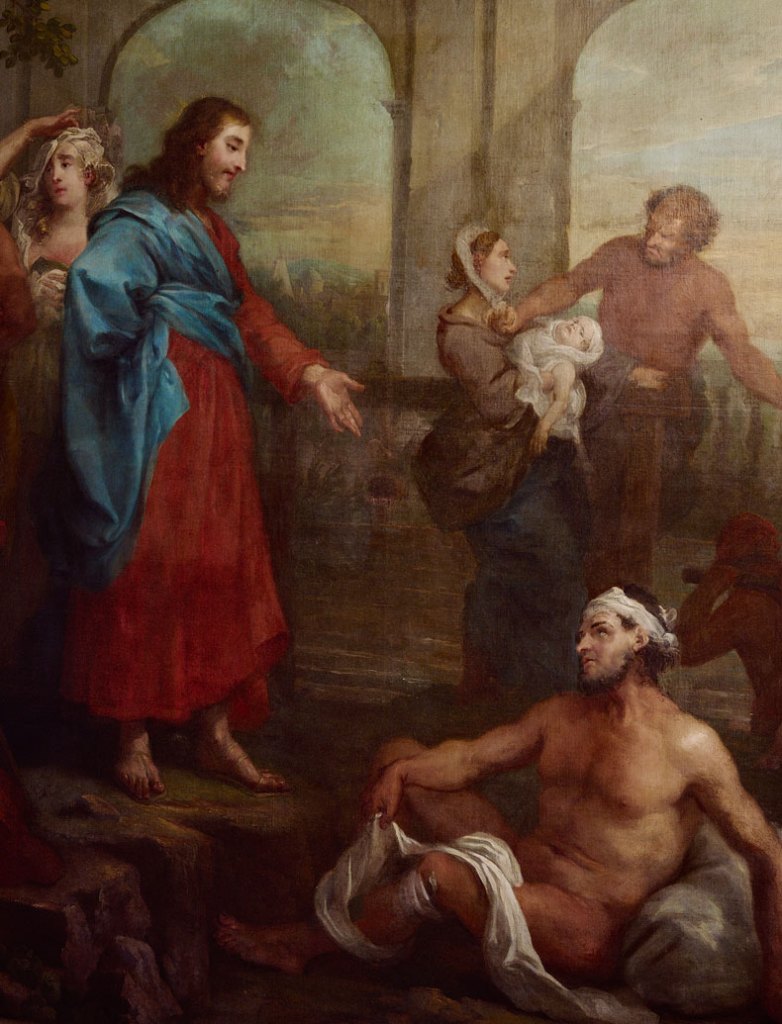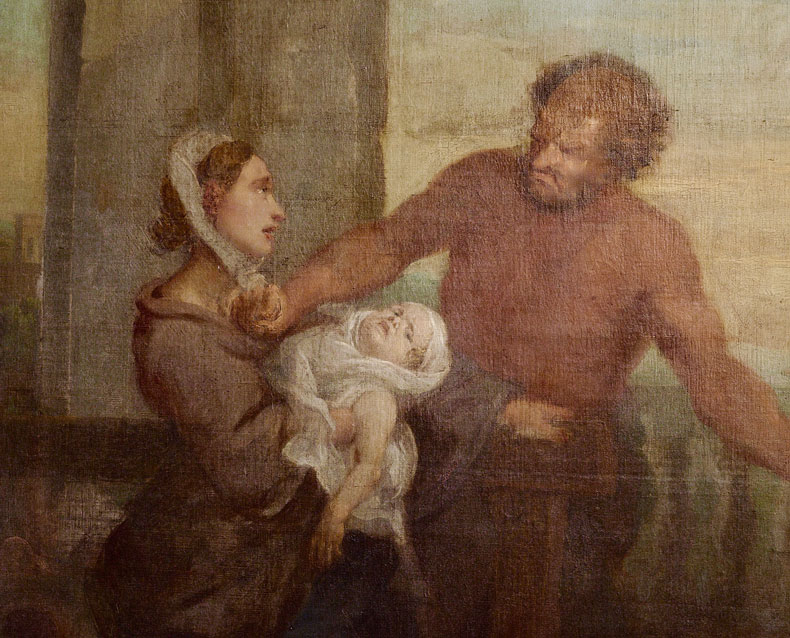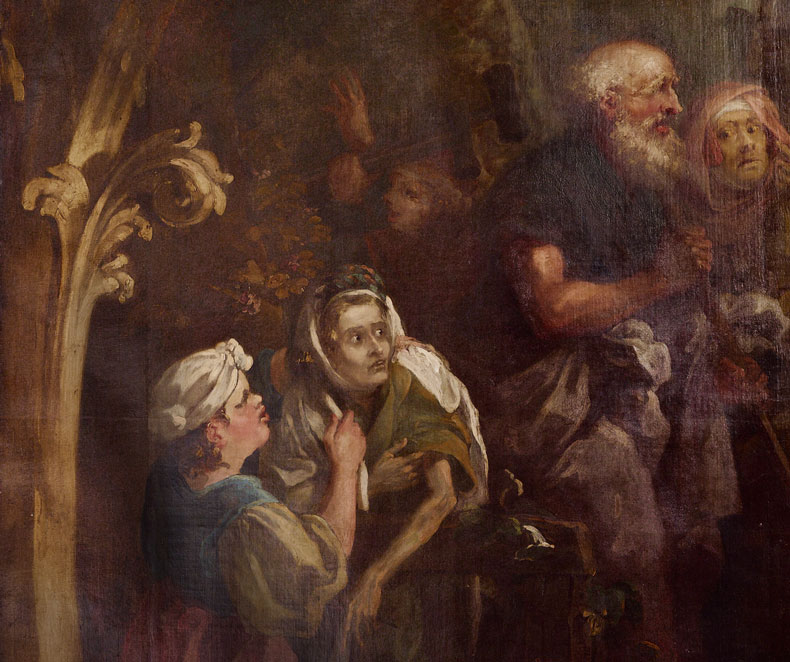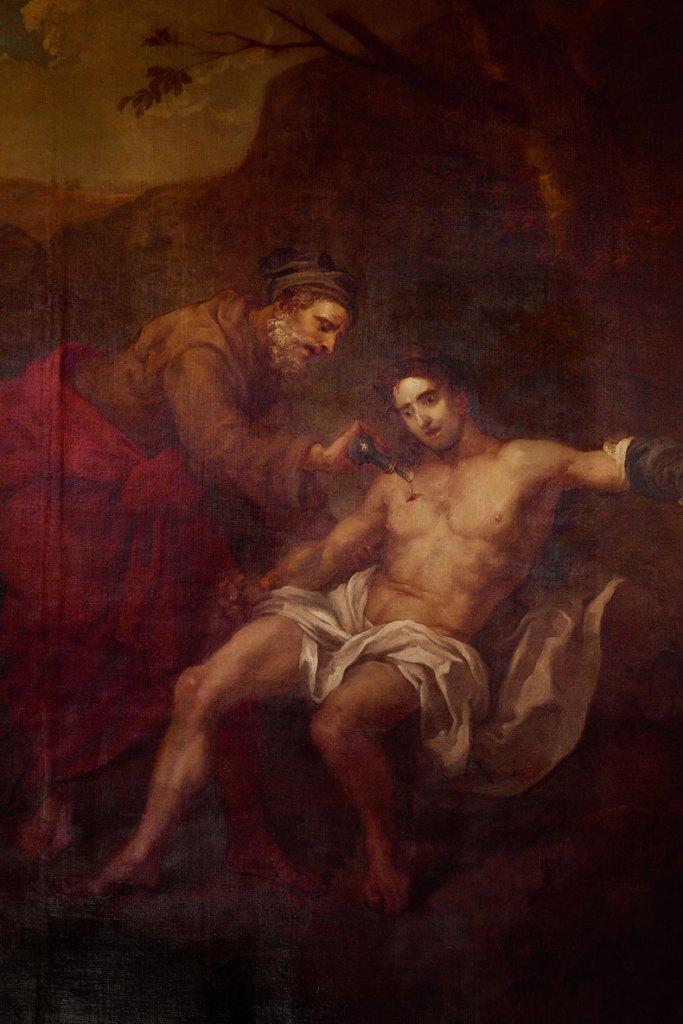From the October 2025 issue of Apollo. Preview and subscribe here.
William Hogarth always had an eye for an opportunity. Fresh from the success of A Rake’s Progress (1732–34), published in engraved form in 1735, he seemed poised to launch into his newly invented genre, the ‘Modern Moral Subject’. But in nearby Smithfield, his local hospital was just emerging from scaffolding. Founded in the 12th century and strategically ‘refounded’ by Henry VIII, St Bartholomew’s Hospital was just metres from the dark timber dwelling where Hogarth had been born; from 1729, it was being rebuilt to designs by James Gibbs. His local pride piqued and ‘without’, as he wrote later, ‘having a stroke of this grand business before’, Hogarth offered the governors a gift: he would cover the stairwell of the new administrative block with two monumental religious paintings: Christ at the Pool of Bethesda and The Good Samaritan. Few people in the 1730s were entirely convinced by Hogarth’s essays in the grand manner to date, his painted output having been confined largely to conversation pieces and portraits – but once they heard the price, it was an offer the hospital authorities could hardly refuse.

It was ultimately a joint effort. The stairwell’s less conspicuous decorative elements – rococo swags and grotesques and large baskets of fruit and flowers – as well as a set of monochromatic scenes from the life of the hospital’s legendary founder, Rahere, were credited by contemporaries to one ‘Mr Richards’. Hogarth’s friend the landscape artist George Lambert (1700–65) provided the backgrounds. Between them, the three covered the whole stairwell, including the ceiling, to magnificent effect, creating an interplay of painting, decorative art and text that unfolds cumulatively, and sinuously, as the visitor works their way up and around the stairs to the hospital’s dining room, concluding with Hogarth’s characterful roundels of the ancient physicians Galen and Hippocrates. The whole installation has just been restored as part of a major renovation project across the Grade I listed North Wing of St Bartholomew’s Hospital (still a working hospital, now generally known simply as ‘Barts’). The site’s caretakers, Barts Heritage, hope this will bring enhanced public access to two of Hogarth’s lesser-known grand-scale projects, as well as offering new opportunities to engage with the hospital’s 18th-century history.
Many of London’s public buildings were being built and rebuilt throughout this period, in the long aftermath of the Great Fire of 1666. Wall paintings were an important part of their visual rhetoric. Hogarth’s pictures were addressed to the hospital’s visitors, staff and potential benefactors, and though he used the visual language of the grand devotional scene, he also used this institutional context to explore a subject that had always interested him: the provision, or denial, of care. At the same time, unlike in A Harlot’s Progress or A Rake’s Progress (both of which feature caregiving prominently in their final scenes), for the Barts commission Hogarth placed this theme within a specifically Christian framework – ‘caritas’ being variously translated as charity, Christian love or benevolence – down to reproducing his source texts from the Gospels, to which his images remain doggedly faithful.

As described in John 5.2-8, the waters of the Pool of Bethesda, located below ‘five porches’, were periodically ‘troubled’ by an angel, rendering them therapeutic to the first person to step in them. Hogarth’s characteristic social commentary pokes through his ambitions in his depiction of the sickly crowd who have gathered here to be healed. An irritable man with his arm in a sling is determined to keep his place in line. The woman next to him, apparently jaundice-stricken, side-eyes a blind man; another distractedly presses her hand to a worryingly inflamed breast, although now her head hurts too. A young mother clutching a miserable rickets-ridden child is trying to speak to the undistinguished underling managing proceedings, but he gestures her to one side, so that an imperious fellow in a fantastical turban can guide his naked paramour through the crowd on a litter. Restoration work has made it easier to spot the sores on her legs, presumably the result of venereal disease. At the top left, and finally free of the lot of them, a young boy turns his joyful face back one last time as he throws his newly useless crutches in the air, but this delirious fantasy of complete physical recovery remains tantalisingly inaccessible, a glimmer in the gloom only visible if you stand at the top of the stairs and peer.

A visitor comes: Jesus, looming ‘7 feet high’ (as Hogarth’s fragmentary autobiographical notes proudly remind us), has light subtly radiating from his head as he stops to speak with an equally monumental recumbent figure who has had an ‘Infirmity thirty & eight years’ but, being unable to walk, has always languished at the water’s edge. A moment later, the Saviour will command the invalid to ‘take up thy bed and walk’ – and he will. Yet Hogarth eschews that moment, rich though it is in visual drama. Instead, he shows Jesus asking, ‘Wilt thou be made whole?’, with the open mouth of the miraculous pool just visible in the space bridging his tenderly inquiring hand and the lame man in the central foreground. It is characteristic of Hogarth to focus on conversation over miracle-making. In this view, Christ is not just the physician doing his rounds; he is the man who stops. This is inevitably also a direct challenge to the viewer, who is, by definition, passing by – either on their way up or down the stairs. Will they answer? At the far right, a solitary figure with a skeletal head, emaciated arm, and grotesquely distended stomach looms from the shadows, an image of physical suffering – and a reminder of mortality – precisely positioned opposite the door to the hospital’s dining room, ready to arrest satiated guests, warm with wine, as they make their way off and out into the night.

Who stops becomes the central motif in Hogarth’s second painting, which is positioned to extend and reflect upon the focal painting of the Pool. This illustrates Christ’s parable of the Good Samaritan. The proud priest who walked by the wounded Israelite stands aloof, at the top of the picture, many metres from the ground and framed against Lambert’s luminous sky. But the eye is more immediately drawn to the monumental figure of the battered, naked man at the bottom, and then to the Samaritan gently dressing his wounds and wearing the same blue and red robes as the Christ on the adjacent wall (albeit dusty and less resplendent). This commission features four of these large-scale nudes: two male, one female, and the partially clad angel; all of them bigger than anything else Hogarth ever painted. Presumably they were the result of recent work in St Martin’s Lane, where Hogarth had just co-founded what George Vertue – self-appointed historian of the 18th-century art scene – referred to as ‘an Academy for drawing from the Life’.

At the same time, the idealised musculature of the two male figures contrasts with their physical vulnerability (just as the desirability of the female figure, for the imagined male viewer, is undermined by evidence of venereal disease). This contrast was becoming familiar across London’s hospital iconography. From 1676–1815, Caius Gabriel Cibber’s larger-than-life nude personifications of Raving Madness and Melancholy Madness (1676) loomed over Moorfields at the public entrance to Bethlem Hospital, popularly known as Bedlam. Melancholy Madness’s Michelangeloesque physique flops uselessly as he gazes fixedly ahead at nothing in particular, while Raving Madness limply lifts his sculpted arms, howling impotently in his chains. Hogarth was certainly familiar with these; indeed, he is thought to have amalgamated them in the image of the semi-nude Tom Rakewell at Bedlam in the final scene of the Rake. However, walking to work through St Bartholomew’s new Henry VIII Gate, Hogarth would also have passed the sculpted semi-draped personifications of ‘Disease’ and ‘Lameness’ sitting on a broken pediment above Gibbs’s statue of the Tudor king. Smaller and more conventional than Cibber’s figures, they cast their eyes heavenward, or (more practically) towards the apex of the hospital, which, like Jesus at Bethesda, offers to make them whole.
Hogarth seems to have been ultimately ambivalent about the Barts pictures. In his later notes, he describes them, using aptly medical terminology, merely as ‘specimen[s]’ to spur on Britain’s native (and, as it proved, for the moment merely hypothetical) history painters. For all that, both pictures are full of confident, characterful painting and evocative ‘Hogarthian’ passages, such as the Samaritan’s injured mastiff licking its wounds and the black-and-white spaniel leaning over (and out of) the illusionistic frame of the Pool as if searching for miraculous waters of its own. Yet it was a project, Hogarth wrote, ‘from which I found no Effects and the reason upon consideration was so plain that I dropt all the old Ideas […] and pursued [modern life scenes]’. Hogarth leaves whatever he considers the ‘plain’ reason for their failure maddeningly unelaborated. But looking at his career in the round, it is still hard to regret his decision to abandon architectural painting – though this restoration restores his gumption to all its original glory.
Barts North Wing, which includes the Hogarth Stair and Great Hall, is open from 6 October.
From the October 2025 issue of Apollo. Preview and subscribe here.